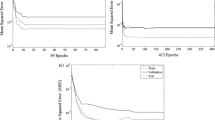Abstract
Accurate forecasting of compressive strength (fc) is one of the important disputes in the concrete industry. Empirical and mathematical models, such as linear and nonlinear regression, have been established. However, these models demand hard empirical work to evolve and can contribute erroneous results when the relationships between actual properties and mixture composition and curing conditions are complex. Several machine learning (ML) models of artificial intelligence overcome such disadvantage in foreseeing the properties of concrete. An Artificial Neural Network (ANN) model, run in a MATLAB platform, for predicting the compressive strength of concrete is established in view of this study. The back-propagation (BP) network with multiple hidden layer is preferred as the structure of the ANN. For assembling the model, a dataset of empirical data was taken from an exploratory research and used for training and testing the model. Finally, the suggested model was validated by the way of the collections’ dataset of prior studies.
Access this chapter
Tax calculation will be finalised at checkout
Purchases are for personal use only
Similar content being viewed by others
References
Gupta S (2013) Concrete mix design using artificial neural network. J Today’s Ideas-Tomorrow’s Technol 1:29–43. http://doi.org/10.15415/jotitt.2013.11003
Yeh IC (2007) Modeling slump flow of concrete using second-order regressions and artificial neural networks. Cem Concr Compos 29:474–480. https://doi.org/10.1016/j.cemconcomp.2007.02.001
Khan SU, Ayub T, Rafeeqi SFA (2013) Prediction of compressive strength of plain concrete confined with ferrocement using artificial neural network (ANN) and comparison with existing mathematical models. Am J Civ Eng Archit 1:7–14. http://doi.org/10.12691/ajcea-1-1-2
Mohamad Ali Ridho BKA, Ngamkhanong C, Wu Y, Kaewunruen S (2021) Recycled aggregates concrete compressive strength prediction using artificial neural networks (ANNs). Infrastructures 6:1–20. http://doi.org/10.3390/infrastructures6020017
da Silveira Bohrer J, Grisci BI, Dorn M (2020) Neuroevolution of neural network architectures using CoDeepNEAT and Keras
Dutta S, Ramachandra Murthy A, Kim D, Samui P (2017) Prediction of compressive strength of self-compacting concrete using intelligent computational modeling. Comput Mater Contin 53:167–185
Rahman A, Majumder A (2014) Prediction of compressive strength of concrete with a skewed pattern application of artificial neural network approach. J Eng Technol Res 104–114
Gupta S (2013) Using artificial neural network to predict the compressive strength of concrete containing nano-silica. Civ Eng Archit 1:96–102. http://doi.org/10.13189/cea.2013.010306
Kao CY, Shen CH, Jan JC, Hung SL (2018) A computer-aided approach to pozzolanic concrete mix design. Adv Civ Eng 2018. http://doi.org/10.1155/2018/4398017
Akpinar P, Khashman A (2017) Intelligent classification system for concrete compressive strength. Procedia Comput Sci 120:712–718. https://doi.org/10.1016/j.procs.2017.11.300
Dabbaghi F, Rashidi M, Nehdi ML, Sadeghi H, Karimaei M, Rasekh H, Qaderi F (2021) Experimental and informational modeling study on flexural strength of eco-friendly concrete incorporating coal waste. Sustainability 13:1–22. https://doi.org/10.3390/su13137506
Chopra P, Sharma RK, Kumar M (2016) Prediction of compressive strength of concrete using artificial neural network and genetic programming. Adv Mater Sci Eng 2016. http://doi.org/10.1155/2016/7648467
Song H, Ahmad A, Farooq F, Ostrowski KA, Maślak M, Czarnecki S, Aslam F (2021) Predicting the compressive strength of concrete with fly ash admixture using machine learning algorithms. Constr Build Mater 308. http://doi.org/10.1016/j.conbuildmat.2021.125021
Trabelsi S, Hafid M, Poncet S, Poirier M, Lacroix M (2017) Rheology of ethylene- and propylene-glycol ice slurries: experiments and ANN model. Int J Refrig 82:447–460. http://doi.org/10.1016/j.ijrefrig.2017.06.035
Boudali S, Abdulsalam B, Rafiean AH, Poncet S, Soliman A, Elsafty A (2021) Influence of fine recycled concrete powder on the compressive strength of self-compacting concrete (SCC) using artificial neural network. Sustainability 13. http://doi.org/10.3390/su13063111
Nehdi M, El Chabib H, El Naggar MH (2001) Predicting performance of self-compacting concrete mixtures using artificial neural networks. ACI Mater J 98:394–401. http://doi.org/10.14359/10729
Author information
Authors and Affiliations
Corresponding author
Editor information
Editors and Affiliations
Rights and permissions
Copyright information
© 2023 The Author(s), under exclusive license to Springer Nature Singapore Pte Ltd.
About this paper
Cite this paper
Amruthamol, N.A., Kapoor, K. (2023). Machine Learning Model to Forecast Concrete Compressive Strength. In: Tiwari, S., Trivedi, M.C., Kolhe, M.L., Singh, B.K. (eds) Advances in Data and Information Sciences. Lecture Notes in Networks and Systems, vol 522. Springer, Singapore. https://doi.org/10.1007/978-981-19-5292-0_12
Download citation
DOI: https://doi.org/10.1007/978-981-19-5292-0_12
Published:
Publisher Name: Springer, Singapore
Print ISBN: 978-981-19-5291-3
Online ISBN: 978-981-19-5292-0
eBook Packages: Intelligent Technologies and RoboticsIntelligent Technologies and Robotics (R0)




